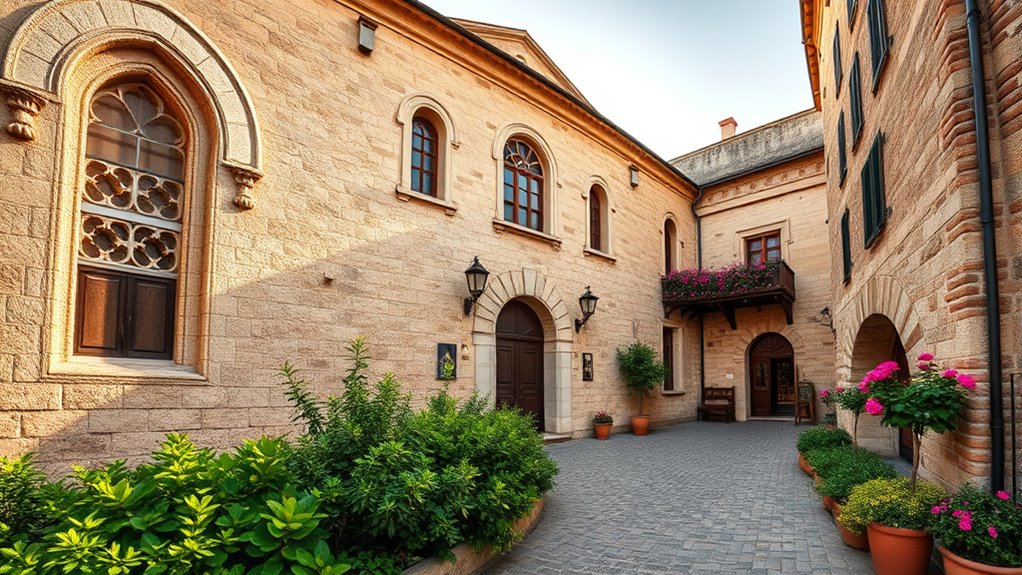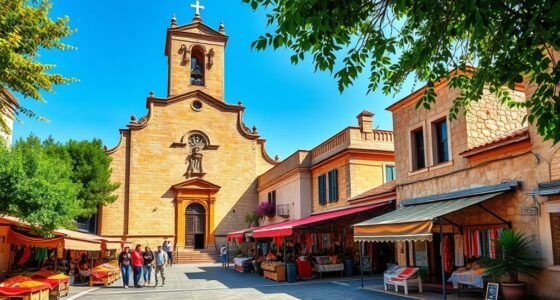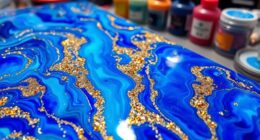If you’re exploring museums near Ittiri, start with the Radio Museum “Mario Faedda” in Ittiri, where you can discover vintage radios and the history of wireless communication. Don’t miss the Museum of Sardinian Heritage in Sassari, showcasing ancient artifacts and ethnography. You might also enjoy the Museo del Corallo in Alghero, highlighting coral craftsmanship. To uncover more about Sardinia’s rich culture, keep exploring the fascinating sites and museums in the area.
Key Takeaways
- The Radio Museum “Mario Faedda” in Ittiri offers a unique collection of radios and insights into Sardinia’s communication history.
- The National Archaeological and Ethnographic Museum “Giovanni Antonio Sanna” in Sassari provides extensive prehistoric and ethnographic exhibits nearby.
- The Museo Del Corallo in Alghero showcases Sardinian coral craftsmanship, just a short drive from Ittiri.
- Archaeological sites like Sa Figu complex and Nuraghe structures offer outdoor cultural exploration close to Ittiri.
- Regional religious sites, including the Church of San Pietro in Vincoli, are accessible for historical visits near Ittiri.
National Archaeological and Ethnographic Museum “Giovanni Antonio Sanna” in Sassari

The National Archaeological and Ethnographic Museum “Giovanni Antonio Sanna” in Sassari offers a compelling glimpse into Sardinia’s rich history and culture. Established in 1878, it was born from Giovanni Antonio Sanna’s donation of art and antiquities. The museum’s building, inaugurated in 1932 and funded by Sanna’s daughter, Zely Castoldi, features classical architectural elements like Doric columns. Between 1966 and 1973, it expanded and modernized to better display its growing collections. Inside, you’ll find archaeological artifacts spanning from the Lower Paleolithic to the Roman Age, along with one of Sardinia’s most extensive ethnographic collections—textiles, jewelry, ceramics, and traditional tools. Situated near Sassari’s historic center, the museum’s scenic garden enhances its cultural atmosphere, inviting you to explore Sardinia’s ancient heritage.
Museo Del Corallo in Alghero
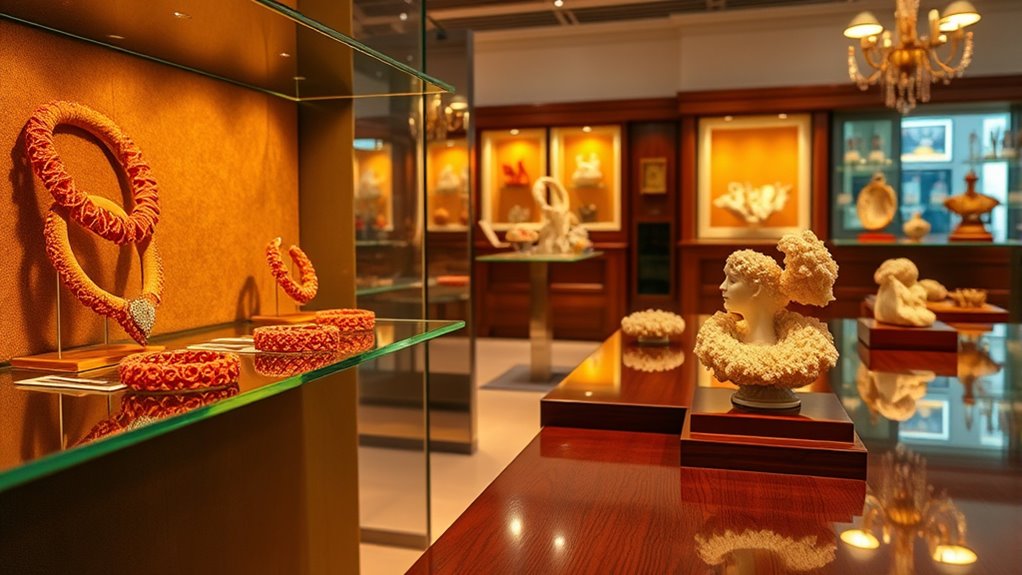
At Museo Del Corallo, you’ll see traditional craftsmanship techniques used to shape and polish red coral into stunning jewelry and sculptures. The exhibits also highlight the strong connection between coral harvesting and the surrounding marine ecology, showing how sustainable practices support both the environment and local artisans. This museum offers a clear look at how craftsmanship and marine life intertwine in Alghero’s cultural heritage.
Coral Craftsmanship Techniques
Exploring coral craftsmanship techniques at the Museo del Corallo reveals a rich tradition rooted in meticulous skill and artistic mastery. You’ll see how artisans transform Mediterranean red coral (Corallium rubrum) into stunning jewelry and sculptures, using tools that have evolved over centuries. The museum showcases each stage—from harvesting and raw material preparation to carving and polishing—highlighting the precision needed to create delicate shapes without damaging the coral. Carving techniques demand careful craftsmanship to preserve the coral’s integrity, while polishing enhances its natural shine and smoothness. You’ll observe a variety of pieces, from simple beads to intricate designs reflecting Alghero’s cultural identity. These techniques, combined with the use of precious metals, demonstrate both artistic innovation and the community’s deep connection to coral, emphasizing its essential role in local tradition and economy. Aura visualization and appreciation can help in understanding the detailed craftsmanship involved in coral artistry.
Marine Ecology Connection
Discover how the artistry of coral craftsmanship is deeply connected to the vibrant marine ecosystem surrounding Alghero. At the Coral Museum, you’ll learn about Corallium Rubrum, or red coral, a essential species in the Mediterranean Sea. This coral creates habitats that support marine biodiversity and is known as “red gold” for its rarity and value. The museum highlights its life cycle, growth stages, and natural habitat, emphasizing sustainable harvesting to prevent overexploitation. You’ll see how red coral has shaped Alghero’s history and economy through jewelry and art, reflecting local culture. Interactive exhibits educate visitors on conservation efforts, responsible fishing, and the ecological importance of protecting this species. Visiting the museum offers insight into how marine ecology and cultural heritage intertwine in Alghero’s identity. Corallium Rubrum plays a crucial role in maintaining the health of the Mediterranean marine environment, supporting a diverse array of marine life. Additionally, understanding the sustainable harvesting practices ensures the preservation of this vital resource for future generations.
Radio Museum “Mario Faedda” in Ittiri

At the Radio Museum “Mario Faedda,” you’ll discover a fascinating history of radio technology through its impressive collection of artifacts. From vintage radios dating back nearly a century to military surplus equipment, the exhibits highlight the evolution of wireless communication. Visiting this museum gives you a clear picture of how radio technology shaped social and technological progress over the years. The museum also hosts special events, such as the annual Marconi Day celebration, which features exhibitions and conferences commemorating the 130th anniversary of wireless telegraphy and the pioneering work of Guglielmo Marconi in 1895. Exploring radio communication innovations, visitors can gain a deeper understanding of how these advancements continue to influence modern wireless technologies.
History of Radio Technology
Have you ever wondered how radio technology evolved from simple spark-gap transmitters to the sophisticated wireless systems we use today? At the Radio Museum “Mario Faedda” in Ittiri, you’ll see this journey firsthand. Situated in a historic mill, the museum celebrates milestones like the 130th anniversary of radiotelegraphy and wireless communication. It highlights key figures such as Guglielmo Marconi, whose birthdate is linked to Italy’s Liberation Day, celebrated with special events. You’ll explore devices from the late 1920s to the 1980s, illustrating technological progress over five decades. Guided tours, technical demonstrations, and active amateur radio stations help you understand how innovations in radio shaped society. The museum serves as both a historical archive and a hub for ongoing learning and community engagement. The museum also hosts special events and exhibitions throughout the year, offering visitors an opportunity to deepen their understanding of radio’s role in history. Additionally, the museum emphasizes the importance of radio technology in modern communications, connecting past innovations to current advancements.
Artifacts and Exhibits
The Radio Museum “Mario Faedda” in Ittiri houses a remarkable collection of over 200 radio devices, spanning from the late 1920s to the 1980s. You’ll find transceivers, accessories, amateur radio telegraph keys, and both civil and military surplus radios, offering a thorough view of telecommunications evolution. A highlight is the “Cge” radio, once central to the community’s broadcasts. The exhibits showcase technological advancements from pre-WWII to late 20th-century innovations. Adjacent displays include an old flour mill and a 1931 corn slush machine, adding historical context. This collection not only demonstrates technical progress but also reflects the social impact of radio in Sardinia. It’s a vivid glimpse into the past, connecting you with the region’s rich communication heritage. Exploring the networks and infrastructure behind these devices further enhances understanding of telecommunications history.
Necropolis of Musellos: An Ancient Burial Site
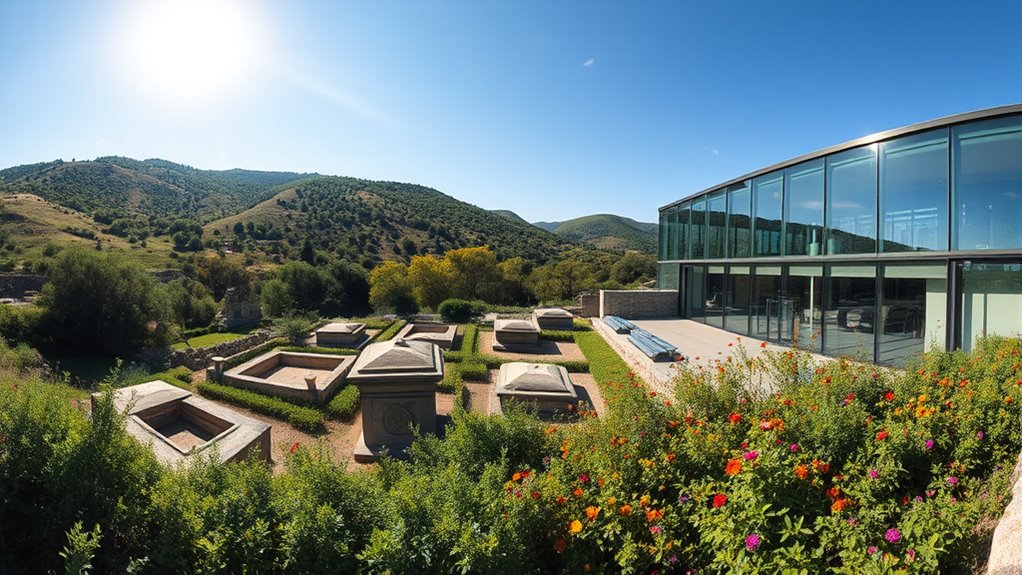
Nestled on the western slope of a limestone hill near Ittiri, the Necropolis of Musellos stands as a remarkable proof of Sardinia’s prehistoric burial traditions. You’ll find six hypogea spread across a broad area, including a main tomb with three chambers aligned north to south. Surrounding it are smaller tombs, some partially hidden by vegetation, and nearby domus de janas of varying sizes. This site dates from 4000 to 3000 BC, reflecting burial customs from the Paleolithic to the Middle Bronze Age, with later Christian symbols engraved on some entrances. Its complex underground architecture highlights advanced prehistoric skills. The site’s significance lies in its layered history, offering insights into evolving rituals and cultural progressions. Archaeological significance emphasizes its importance in understanding ancient Sardinian societies.
Sa Figu Archaeological Complex and Prehistoric Ruins
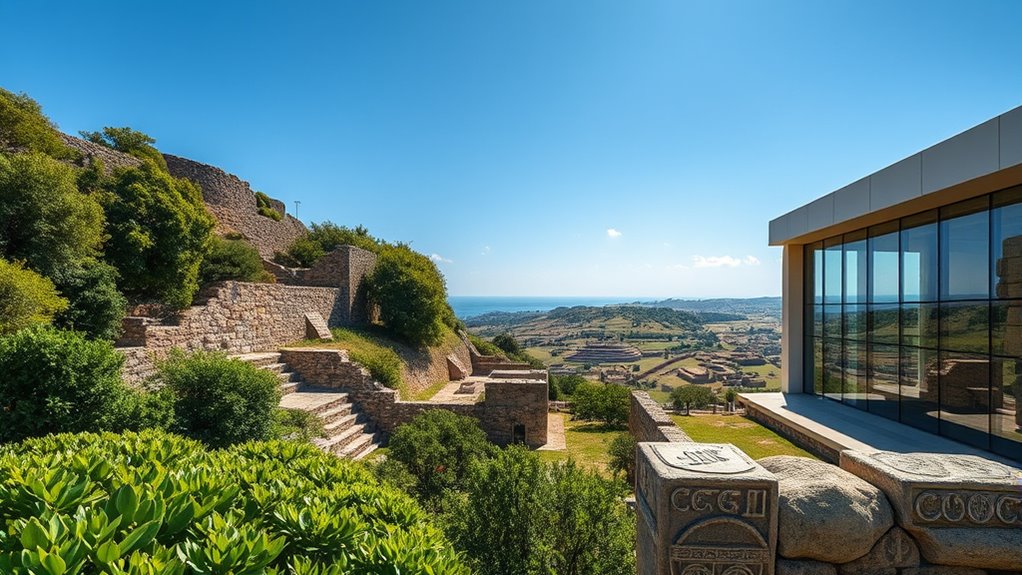
You can explore the archaeological significance of Sa Figu, where prehistoric remains span from the Neolithic to the Bronze Age. The site displays impressive artifacts, including Nuragic statuettes and megalithic structures, offering a glimpse into ancient cultures. Its accessibility within a regional park makes it easy to visit and discover Sardinia’s rich prehistoric history. Situated along the northern edge of the Coros plateau in Ittiri, the complex is easily reachable by local routes from nearby towns and landmarks. Recognizing the importance of cultural heritage enhances appreciation for these ancient sites and their stories.
Archaeological Significance
Located on Sardinia’s northern plateau, the Sa Figu archaeological complex offers a remarkable glimpse into prehistoric times through its diverse monuments and ruins. This site spans multiple eras, from the late Neolithic to the Iron Age, showcasing a continuous cultural evolution. You’ll find hypogea, megalithic circles, and nuraghi, illustrating complex funerary and settlement practices. The tombs, including simple and expanded domus de janas, reflect changing burial customs, while nearby megalithic features highlight the site’s ceremonial importance. The site’s layered history makes it a crucial window into Sardinia’s prehistoric civilization. Its strategic location provides panoramic views, connecting you visually and culturally to Sardinia’s ancient past.
| Feature | Description |
|---|---|
| Tombs | Domus de janas, multi-chamber, and expanded tombs |
| Structures | Megalithic circle, nuraghe base, dolmens |
| Timeline | Neolithic to Iron Age, Nuragic period |
| Significance | Transition of burial practices and cultural layers |
Prehistoric Artifacts Display
The Sa Figu archaeological complex offers a compelling showcase of prehistoric artifacts that reveal Sardinia’s ancient cultural practices. You’ll find a diverse collection of objects spanning thousands of years, illustrating evolving artistic and ritual traditions. Notable artifacts include:
- Nuragic bronze statuettes, like the launeddas player, highlighting artistic craftsmanship.
- Pottery shards from Neolithic to Bronze Age, showing stylistic progressions.
- Stone tools and weapons from Copper and Bronze Ages, reflecting daily life and craftsmanship.
- Funerary steles and decorated walls within hypogea, emphasizing ritualistic significance.
- The complex also features remnants of prehistoric settlements, providing insight into early human habitation and community organization in the region.
These discoveries not only shed light on burial customs but also demonstrate the development of prehistoric Sardinian society, art, and technology across millennia.
Site Accessibility
Accessing the Sa Figu archaeological complex involves a scenic climb from the sanctuary of San Maurizio to the site’s peak, where natural trails wind through Sardinian limestone outcrops. The terrain is uneven, with no paved roads or shuttle services, so good mobility is essential. This open-air park features eleven hypogea, a megalithic circle, and proto-nuraghe remains, all exposed to natural elements. There are no dedicated facilities like ramps, signage for disabled visitors, or visitor centers. Prepare for the outdoor environment with sturdy footwear and weather protection. The site’s natural trails and rocky landscape make it ideal for hikers in good shape, but challenging for those with mobility issues.
| Feature | Description |
|---|---|
| Terrain | Uneven, natural limestone outcrops |
| Approach | Scenic climb from San Maurizio sanctuary |
| Facilities | None, outdoor archaeological park |
| Accessibility Features | None, no ramps or signage for disabled visitors |
| Amenities | Minimal; no restrooms or visitor centers |
Nuraghe Majore and Nuraghe Monte Torru

Have you ever wondered about the ancient stone structures dotting the Sardinian landscape near Ittiri? Nuraghe Majore and Nuraghe Monte Torru showcase Sardinia’s rich prehistoric heritage. Here’s what makes them special:
- Nuraghe Majore sits atop a granite dome at 498 meters, offering strategic views and a network of nearby nuraghes like Lu Polcu and Budas. Nuraghe structures are the most numerous and iconic monuments of the Nuragic civilization. The construction techniques used in these nuraghes demonstrate complex building methods that have fascinated archaeologists for decades.
- Its architecture blends Middle to Late Bronze Age features, with vaulted floors and a tholos chamber, reflecting evolving construction techniques.
- Nuraghe Monte Torru is smaller but shares typical tholos design, part of a regional defense network.
- Both sites reveal complex construction methods, serving roles from defense to social symbols, and highlight Sardinia’s enduring Nuragic civilization.
Church of San Pietro in Vincoli and Medieval Religious Sites

Nestled in Ittiri, the Church of San Pietro in Vincoli showcases a blend of medieval architecture and historical significance that invites exploration. Its single apsed aisle features five side chapels with Gothic elements and stellar vaults from the 15th century. The apse’s starry vault highlights craftsmanship, while the bell tower combines a square base with a later octagonal addition. Renovated between 1881 and 1895, the façade reflects neoclassical style using red vulcanite stone. Inside, wall paintings by Baldassarre Manca and Mario Paglietti adorn chapels, blending medieval and 19th-century artistry. A marble plaque from 1896 marks the main altar’s consecration. The preservation of such historical significance ensures the ongoing appreciation of medieval religious sites.
Cistercian Abbey of Santa Maria De Paulis and Nostra Signora De Coros

The Cistercian Abbey of Santa Maria De Paulis and the Church of Nostra Signora De Coros stand as important monuments of medieval monastic life in Sardinia. You can explore the abbey’s origins, founded in 1205 by King Comita II, nestled in a marshy landscape linked to ancient Roman roads. Its limestone walls and cross-shaped church reveal typical Cistercian architecture, with three naves, a choir, and remnants of cloisters. Meanwhile, Nostra Signora De Coros served as a priorate and hermitage, dating to the early 13th century, with surviving medieval walls and a vaulted ceiling. Both sites highlight the religious and architectural influence of the Cistercian order in Sardinia. Additionally, the highly intelligent dog breeds like the Golden Retriever and Poodle have historically been associated with roles that require obedience and training, reflecting their prominent place in human society.
Sassari Cathedral of St. Nicholas and Ducal Palace

Sassari Cathedral of St. Nicholas, built in the 12th century, showcases a mix of architectural styles due to centuries of reconstruction. You’ll notice Romanesque origins with remnants beneath the apse, along with Gothic, Renaissance, Baroque, and Neoclassical influences. The 13th-century bell tower remains from the original structure, while a turret with a dome was added later. The façade, completed in 1759, features three levels with a porch, niches with statues of local martyrs, and a statue of Saint Nicholas. Inside, you’ll see a blend of Gothic ribbed vaults and Baroque elements. Nearby, the Ducal Palace served as the residence for Sassari’s dukes and administrators, adding historical significance to your visit to this vibrant religious and cultural site.
Cultural Festivals and Local Crafts Exhibitions
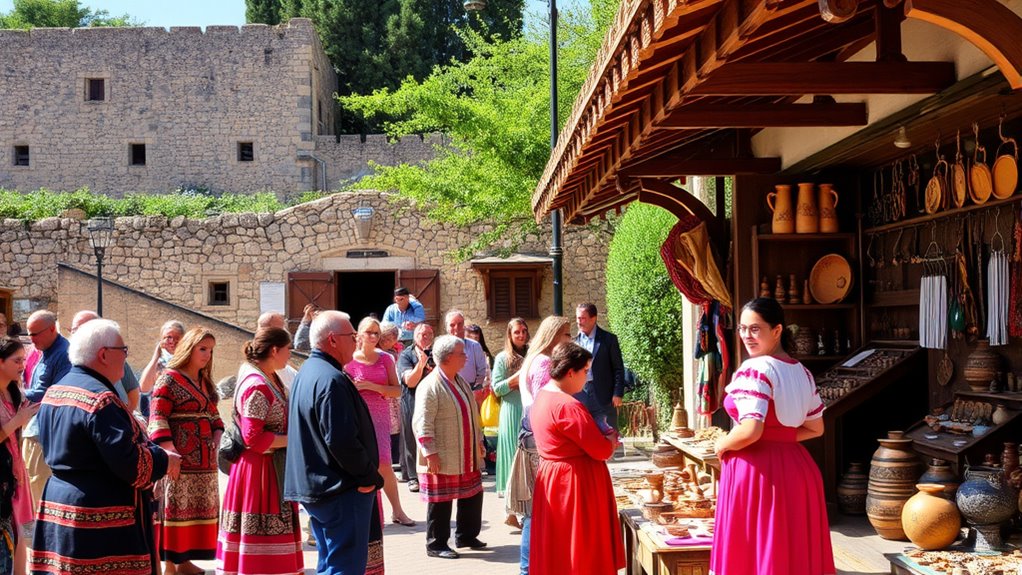
Attending the Ittiri Folk Festa offers a vibrant immersion into Sardinian culture through lively folk dance, music, and craft exhibitions. During the festival, you’ll encounter displays showcasing traditional textiles, ceramics, and woodwork from Sardinia and visiting cultures. The exhibitions open from the start and stay open into the evening, giving plenty of time to explore. You can join hands-on workshops and watch artisan demonstrations, witnessing both ancient techniques and modern reinterpretations. Here’s what you shouldn’t miss:
- Traditional textiles, ceramics, and woodwork displays
- Handcraft workshops and artisan demonstrations
- Cultural stalls offering unique local crafts
- Evening exhibitions highlighting Sardinian and international folk art
Salude & Trigu Program features over 100 events across Sassari and Olbia-Tempio in 2025, showcasing Sardinian culture and traditions. This festival provides a perfect chance to connect with local traditions and appreciate the region’s rich craft heritage.
Frequently Asked Questions
Are There Guided Tours Available at These Museums Near Ittiri?
You’ll find guided tours at several nearby museums, offering immersive explorations into Sardinian craft and culture. The Museum of Mediterranean Weaving, Ethnographic Museum of Sardinia, and the Museum for the Art of Copper and Textile in Isili all provide expert-led visits. Be sure to book in advance, especially during peak seasons or special events. Guides share stories about traditional techniques, local history, and artisan tools, enriching your experience and understanding.
Which Museums Are Suitable for Children and Family Visits?
You’re curious about museums perfect for family visits. You’ll enjoy the Ethnographic Museum of Sardinia near Ittiri, which offers engaging exhibits suitable for children. The Nuragic archaeological sites, like Santu Antine, provide outdoor fun and educational exploration. Additionally, museums with hands-on activities, such as the Textile Museums or the Museo delle Palafitte di Fiavè, let your family learn through play, making your visit both fun and educational.
What Are the Opening Hours and Admission Fees for These Museums?
You’re curious about visiting museums near Ittiri, and the details matter! Most open Tuesday to Sunday, from 9 or 9:30 AM until 6 or 7 PM, with seasonal variations. Admission fees range from €5 to €15, depending on the museum. Some offer free entry on specific days or discounts. Planning ahead by checking exact hours and booking tickets online can make your visit smoother and more enjoyable.
Can I Find Local Handicrafts or Souvenirs at These Museum Sites?
You won’t typically find local handicrafts or souvenirs directly at museums in Ittiri, as most focus on history and architecture rather than retail. Instead, explore nearby town markets and artisan shops, where you can buy Sardinian textiles, ceramics, and jewelry. Cultural events and festivals are great opportunities to purchase authentic crafts, so make sure to visit local markets for a true taste of Sardinian craftsmanship.
Are Any of These Museums Accessible for Visitors With Mobility Challenges?
Did you know that over 80% of Sardinian museums have limited accessibility due to historic structures? You might find it challenging to navigate some sites with uneven floors and cobbled streets. While larger museums like Sassari’s National Archaeological Museum offer ramps and elevators, many local sites lack full accessibility. To guarantee an enjoyable visit, contact museums ahead of time for specific details and consider those with recent restorations.
Conclusion
Ready to explore Ittiri and its surroundings? From ancient burial sites to vibrant festivals, these museums and historic sites offer a glimpse into Sardinia’s rich heritage. Will you let these treasures inspire your journey? Don’t miss the chance to immerse yourself in the culture, history, and natural beauty that make Ittiri truly special. Pack your curiosity and come discover what makes this region unforgettable—are you ready for your adventure?
